Completed infrastructure projects in the national park reserve
Pacific Rim National Park Reserve
Table of Contents
Grice Bay and McLean Point Remediation Project
Wick Road Bridge and salmon habitat restoration
Washrooms at Long Beach South and North, Wickaninnish Beach and Incinerator Rock
West Coast Trail – Logan Creek
Rainforest Trail Pacific Rim highway crossing
ʔapsčiik t̓ašii (pronounced ups-cheek ta-shee): The new multi-use pathway
Completed in summer of 2022, ʔapsčiik t̓ašii is a 25 km multi-use pathway through the Long Beach Unit of Pacific Rim National Park Reserve.
Built in consultation and partnership with Tla-o-qui-aht First Nations and Yuułuʔiłʔatḥ and using best practices and innovative strategies to minimize environmental and cultural impacts. The pathway provides access to new and existing viewpoints and facilities.
More information:
Grice Bay and Mclean Point Remediation Project
The Federal Contaminated Sites Action Plan (FCSAP) was established in 2005 as a 15-year program with funding of $4.54 billion from the Government of Canada. The program was renewed for another 15 years (2020 to 2034) with $1.16 billion announced in Budget 2019 for the first five years (Phase IV, 2020 to 2024).
The objective of FCSAP is to reduce environmental and human health risks from known federal contaminated sites and associated federal financial liabilities, while focusing on the highest priority sites.
The scope of the project at Pacific Rim National Park Reserve included removing old underground fuel reservoirs and areas of contaminated soil at McLean Pt and Grice Bay, resurfacing the Grice Bay parking lot, and replacing a section of the Grice Bay boat ramp.
Wick Road Bridge and salmon habitat restoration
Spawning and juvenile salmon can now access previously unreachable habitat thanks to the replacement of an old, collapsing culvert with a clear-span bridge on Wick Road. This project is one of the most ecologically-effective salmon habitat restoration projects in the history of the national park reserve. Watch the time-lapse video to see the installation of the bridge and return of wildlife to the creek. This project was completed in June, 2016.
Restoring Salmon Habitat on Sandhill Creek
Transcript
Text: Restoring Salmon Habitat on Sandhill Creek - Pacific Rim National Park Reserve.
Text: The Wick Road culvert on Sandhill Creek was a barrier for many salmon attempting to reach spawning grounds and nursery habitat.
Text: To address this, Parks Canada replaced the culvert with a bridge and created a fish-friendly environment under and around it.
Text: The project was the largest effort in salmon habitat restoration in the national park reserve's history.
[Timelapse of tractors and construction workers digging up the old culvert, shaping the ground, adding boulders and crushed stone. The workers remove a temporary dam allowing water to flow into the new creek terrain.]
[A series of images show the old culvert, the bridge during construction, and the completed project.]
[Several shots show salmon swimming through the new habitat beneath the completed bridge.]
Text: The creek is flowing freely for the first time in 18 years.
Text: This project has opened up additional spawning habitat for adult salmon and safe nursery areas for juveniles!
Text: Now bears are returning to the stream to feed. Their leftovers will fertilize the forest. It's the circle of life and shows how restoring this stream has benefits for the whole ecosystem and protection of Pacific Rim National Park Reserve!
Parks Canada logo.
© Her majesty the Queen in Right of Canada. Represented by Parks Canada, 2017.
Canada wordmark.
Washrooms at Long Beach South and North, Wickaninnish Beach and Incinerator Rock
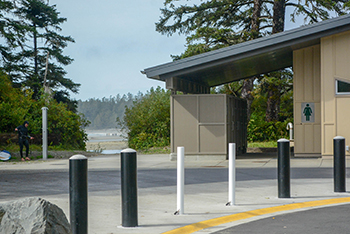
Green Point Campground
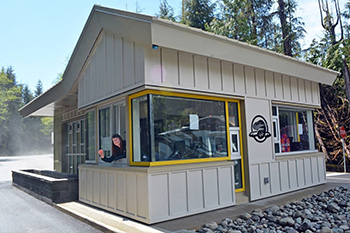
A new entrance kiosk with a wider entrance allows visitors to by-pass the line-up if they have already registered at the campground. Four new washroom buildings with hot showers and kitchen sinks; electrical hook-ups; new fire rings; picnic table; and an RV sani-station are some of the significant improvements we’ve made to Green Point Campground between 2015 and 2019.
West Coast Trail – Logan Creek
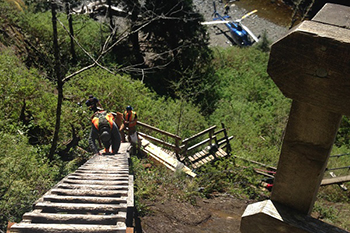
Since 2015, the Government of Canada funded bridge and ladder improvements along the iconic 75 km West Coast Trail. The West Coast Trail is shared with Huu-ay-aht, Ditidaht and Pacheedaht First Nations. Logan Creek, known as wi?e:?, lies in the traditional territory of the Pacheedaht.
One improvement to the West Coast Trail is a new suspension bridge constructed in 2019 crossing Logan Creek. This project is an example of engineering excellence that replaced the old bridge and ladder system due to slope instability.
Spanning 113 metres, the Logan Creek Bridge is one of the longest suspension bridges in British Columbia, offering stunning views of Logan Creek 40 metres below as it empties into the Pacific Ocean. The new bridge will provide hikers with a safer—and certainly a less exhausting—crossing at the same elevation as the trail further upstream than the old bridge system.
Note that only registered West Coast Trail hikers can access Logan Creek Suspension Bridge. It is not accessible by car.
Building the bridge in such a remote location was a challenge: bridge components, tools and machinery had to be flown in and out by helicopter. Each trip was strategically planned around the same natural forces that make the hike so arduous: heavy rain, fog banks, and high winds. To minimize wildlife interactions, the contractor even transported a bear safe storage container to the site for all food and waste, and installed an electric fence around the work site.
Throughout the project, Parks Canada ensured that contractors followed environmental and cultural standards. At critical times such as during bird nesting periods, environmental monitors were on site. We worked with Pacheedaht First Nation on both cultural and environmental monitoring, ensuring any culturally sensitive trees or areas were cared for appropriately.
The West Coast Trail just got a stunning suspension bridge!
Transcript
00:00 On one of Canada’s most grueling and spectacular hikes, Parks Canada built a new suspension bridge 00:06 The bridge is 113 m long and towers 40 m above Logan Creek, on the West Coast Trail in Pacific Rim National Park Reserve 00:13 It replaces the old ladder-and-bridge crossing, which could no longer support repairs 00:19 The bridge lies in the traditional territory of the Pacheedaht First Nation, who call the area wi?e:? (pronounced wi-eh) 00:26 The nation’s relationship with the land continues to this day 00:33 The bridge was funded by the Federal Infrastructure Investment Program in 2018 00:39 Building a bridge in British Columbia’s backcountry was not easy 00:46 We took great care to minimize environmental and cultural heritage impacts to the land 00:53 Tools and materials had to be delivered by helicopter 01:00 Trips were planned around heavy rain, fog banks, and high winds 01:06 The same natural forces that make the hike challenging 01:13 First, workers cleared the area for the bridge foundations 01:20 Then poured footings using concrete flown in by helicopter 01:27 Anchors for the suspension bridge were drilled, grouted, and tested by the geotechnical engineer 01:34 Cables were strung across the canyon and the metal bridge structure was pieced together 01:41 Finally, the old bridge-and-ladder system was dismantled 01:47 Monitors from Pacheedaht First Nation and Parks Canada observed activities 01:53 They advised the crew on tree felling, archaeological monitoring and identifying culturally modified trees 02:01 The new bridge spans from bank to bank, without the need for a ladder system 02:07 Now hikers can continue to enjoy the West Coast Trail for years to come 02:14 And the unforgettable experience of this challenging hikeRainforest Trail
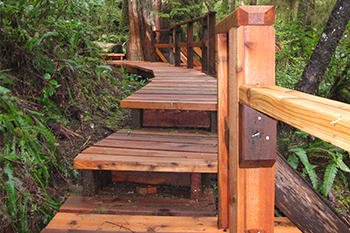
The Rainforest Trail has always been a popular destination, but after some creative improvements to the cedar boardwalk and stairs, the A and B trails are receiving rave reviews from visitors for this amazing coastal rainforest experience. During this project, Parks Canada staff replaced two kilometres of decaying cedar board walk over two winters to minimize the impact to visitors. Trail A was finished in April of 2017, and Trail B was finished in April of 2018.
Rainforest Trail Pacific Rim highway crossing
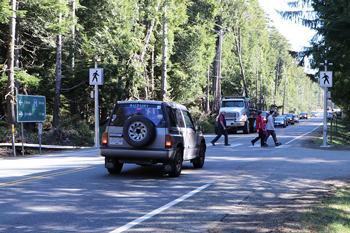
A highly visible pedestrian-controlled crosswalk now connects the two halves of the Rainforest Trail. Completed in March 2019, this new infrastructure is a further enhancement to the area to ensure pedestrian and motorist safety. Parks Canada had previously installed a painted crosswalk, lowered the speed limit and installed signs warning drivers of the reduced speed limit at the Rainforest Trails, and despite these efforts, drivers continue to drive over the speed limit, placing pedestrians at risk. The new crosswalk will provide motorists significant warning to slow down and stop, to allow pedestrians to safely cross the Pacific Rim Highway to get to Rainforest Trail A and the beautiful boardwalks that wind through the coastal rainforest.
Radar Hill lookout and road

In June, 2016, Radar Hill, known for spectacular views of Long Beach to the south and Clayquot Sound to the north, opened back up to visitors with new viewing platforms, stairs and benches. The road was also repaired and resurfaced to address safety and accessibility issues related to large potholes, buckling stretches of pavement, and road slippage.
Kwisitis Visitor Centre roof
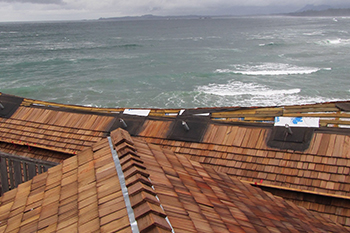
With an average of more than three metres of rain in the region each year, a new roof on the Kwisitis Visitor Centre was a top priority. This iconic building has been captured in thousands of visitor photos, presents two floors of displays and interactive exhibits in English, French and Nuu-chah-nulth, and is the starting point for some of Parks Canada’s most popular interpretive programs in the summer months. The new roof was completed in December, 2017.
Wick Road
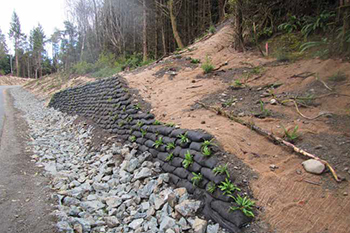
The section of Wick Road between the Shorepine Bog Trail and Wickaninnish Beach was upgraded with new culverts and improved drainage; and, resurfaced to provide visitors with smoother, safer access to beautiful Wickaninnish Beach and the Kwisitis Visitor Centre. The S-curve was realigned to make it safer, along with the addition of coco matting, rocks, and 900 plants to stabilize the banks. The Kwisitis Visitor Centre parking lot and the Wickaninnish Beach parking lots have all been resurfaced. This work was completed in October, 2017.
Grice Bay
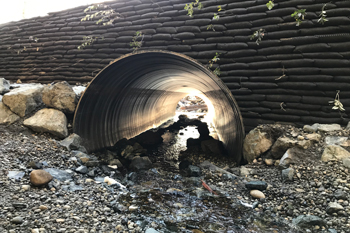
Grice Bay Road Parks Canada has been making a number of improvements to Grice Bay Road since 2017. In November 2019, Grice Bay Road and boat ramp area reopened to users following the replacement of a failing culvert, slope stabilization work and improvements to drainage. The new stream crossing and habitat restoration work will help enhance access to salmon so they can more easily reach important spawning grounds and nursery habitats. The freshly paved road also boasts a newer design, which will improve motorist safety. This work will ensure visitors continue to have safe, reliable, long-term access to beautiful Grice Bay and the surrounding area.
Other projects
- Upgrades to water and sewer utilities throughout the Long Beach Unit of the national park reserve; 2015-2017.
- Slope stabilisation, culvert replacement and resurfacing on Grice Bay Road; completed July, 2016.
- Replacement of six failing culverts at Swim Beach on Kennedy Lake; completed March, 2016.
- A lower traffic speed and improved safety at the Rainforest Trail crosswalk; completed September 2015.
- Date modified :